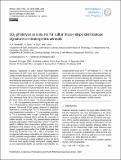| dc.contributor.author | Jiang, B. | |
| dc.contributor.author | Guo, H. | |
| dc.contributor.author | Whitehill, Andrew Richard | |
| dc.contributor.author | Ono, Shuhei | |
| dc.date.accessioned | 2015-04-08T17:15:35Z | |
| dc.date.available | 2015-04-08T17:15:35Z | |
| dc.date.issued | 2015-02 | |
| dc.date.submitted | 2014-12 | |
| dc.identifier.issn | 1680-7324 | |
| dc.identifier.issn | 1680-7316 | |
| dc.identifier.uri | http://hdl.handle.net/1721.1/96434 | |
| dc.description.abstract | Signatures of sulfur isotope mass-independent fractionation (S-MIF) have been observed in stratospheric sulfate aerosols deposited in polar ice. The S-MIF signatures are thought to be associated with stratospheric photochemistry following stratospheric volcanic eruptions, but the exact mechanism responsible for the production and preservation of these signatures is debated. In order to identify the origin and the mechanism of preservation for these signatures, a series of laboratory photochemical experiments were carried out to investigate the effect of temperature and added O[subscript 2] on the S-MIF produced by two absorption band systems of SO[subscript 2]: photolysis in the 190 to 220 nm region and photoexcitation in the 250 to 350 nm region. The SO[subscript 2] photolysis (SO[subscript 2] + hν → SO + O) experiments showed S-MIF signals with large [superscript 34]S[over [superscript 34S] fractionations, which increases with decreasing temperature. The overall S-MIF pattern observed for photolysis experiments, including high [superscript 34]S[over [superscript 34S] fractionations, positive mass-independent anomalies in [superscript 33]S, and negative anomalies in [superscript 36]S, is consistent with a major contribution from optical isotopologue screening effects and data for stratospheric sulfate aerosols. In contrast, SO[subscript 2] photoexcitation produced products with positive S-MIF anomalies in both [superscript 33]S and [superscript 36]S, which is different from stratospheric sulfate aerosols. SO2 photolysis in the presence of O[subscript 2] produced SO[subscript 3] with S-MIF signals, suggesting the transfer of the S-MIF anomalies from SO to SO[subscript 3] by the SO + O[subscript 2] + M → SO[subscript 3] + M reaction. This is supported with energy calculations of stationary points on the SO[subscript 3] potential energy surfaces, which indicate that this reaction occurs slowly on a single adiabatic surface, but that it can occur more rapidly through intersystem crossing. Based on our experimental results, we estimate a termolecular rate constant on the order of 10−37 cm[superscript 6] molecule[superscript −2] s[superscript −1]. This rate can explain the preservation of mass independent isotope signatures in stratospheric sulfate aerosols and provides a minor, but important, oxidation pathway for stratospheric SO[subscript 2]. The production and preservation of S-MIF signals requires a high SO[subscript 2] column density to allow for optical isotopologue screening effects to occur and to generate a large enough signature that it can be preserved. In addition, the SO[subscript 2] plume must reach an altitude of around 20 to 25 km, where SO[subscript 2] photolysis becomes a dominant process. These experiments are the first step towards understanding the origin of the sulfur isotope anomalies in stratospheric sulfate aerosols. | en_US |
| dc.description.sponsorship | United States. National Aeronautics and Space Administration (Exobiology Program. NNX10AR85G) | en_US |
| dc.description.sponsorship | National Science Foundation (U.S.). Frontiers in Earth System Dynamics (Award 1338810) | en_US |
| dc.language.iso | en_US | |
| dc.publisher | Copernicus GmbH | en_US |
| dc.relation.isversionof | http://dx.doi.org/10.5194/acp-15-1843-2015 | en_US |
| dc.rights | Creative Commons Attribution | en_US |
| dc.rights.uri | http://creativecommons.org/licenses/by/3.0/ | en_US |
| dc.source | Copernicus Publications | en_US |
| dc.title | SO[subscript 2] photolysis as a source for sulfur mass-independent isotope signatures in stratospehric aerosols | en_US |
| dc.type | Article | en_US |
| dc.identifier.citation | Whitehill, A. R., B. Jiang, H. Guo, and S. Ono. “SO[subscript 2] Photolysis as a Source for Sulfur Mass-Independent Isotope Signatures in Stratospehric Aerosols.” Atmospheric Chemistry and Physics 15, no. 4 (2015): 1843–1864. | en_US |
| dc.contributor.department | Massachusetts Institute of Technology. Department of Earth, Atmospheric, and Planetary Sciences | en_US |
| dc.contributor.mitauthor | Whitehill, Andrew Richard | en_US |
| dc.contributor.mitauthor | Ono, Shuhei | en_US |
| dc.relation.journal | Atmospheric Chemistry and Physics | en_US |
| dc.eprint.version | Final published version | en_US |
| dc.type.uri | http://purl.org/eprint/type/JournalArticle | en_US |
| eprint.status | http://purl.org/eprint/status/PeerReviewed | en_US |
| dspace.orderedauthors | Whitehill, A. R.; Jiang, B.; Guo, H.; Ono, S. | en_US |
| dc.identifier.orcid | https://orcid.org/0000-0001-5996-8217 | |
| dc.identifier.orcid | https://orcid.org/0000-0002-1348-9584 | |
| mit.license | PUBLISHER_CC | en_US |
| mit.metadata.status | Complete | |
